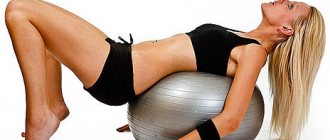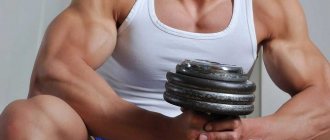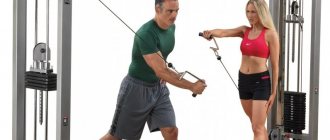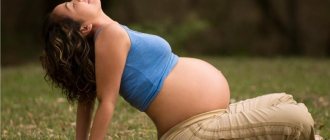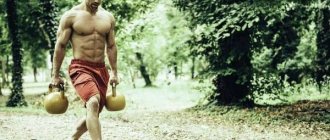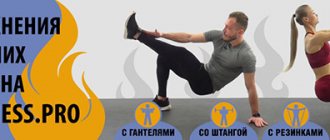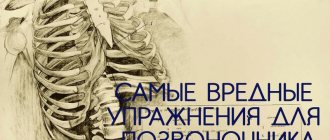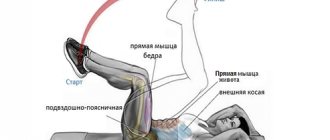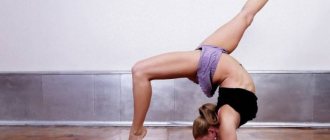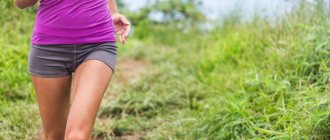The “Hundred” exercise is considered one of the most effective exercises from the Pilates system. Its implementation helps to fully work out the abdominal muscles and keep them in good shape all the time. It got its name because of the unusual way of breathing, consisting of 10 approaches (10 inhalations and 10 exhalations).
This exercise is also actively used to warm up muscle groups before training on the mat.
Golden Pilates exercise. “Hundred” for absolutely all abdominal muscles!
Date of publication: 05/23/2017
“The Hundred” is one of the most popular Pilates exercises . When performing it, all the muscles of the abdominal cavity work. This golden exercise got its name due to a special breathing technique.
This exercise consists of 10 breathing cycles. Each includes 5 inhalations and 5 exhalations. The “hundred” can be performed by a person of any age and any level of physical fitness due to the fact that there are many options for performing the exercise.
“Hundred” is the perfect solution for warming up . It warms up both the abdominal and arm muscles in the shoulder joint, as well as the chest muscles that we use for breathing.
https://youtu.be/zry6X5zxmEs
Rules for beginners
Pilates for beginners at home
Those who want to join the physical culture of Pilates must initially know what it is and what its benefits are. People who have read about this topic and who “have become acquainted with it” from the words of friends are not yet beginner Pilates trainees. In order for exercises performed independently at home to be beneficial and effective from the first workout, you need to listen to the following advice:
- choose the program strictly individually, in accordance with your level of physical fitness;
- work with your own weight, do not rush to use weights and special exercise equipment;
- watch video lessons in your native language;
- be collected and concentrated;
- know that quality is more important than quantity here;
- listen to yourself, be honest with yourself;
- if you are tired, take a “short break”;
- Remember, these are low-impact, low-intensity workouts.
Now, knowing the “moral” of Pilates and to start doing Pilates exercises at home for beginners, all you need is desire and a soft fitness mat.
Pilates exercises for beginners: you need desire and a soft mat
All reviews about the effectiveness or benefits of Pilates are divided into positive and negative. The last of them is the opinion of people who started doing workouts that do not correspond to their physical fitness or state of health, and also do not know how to “listen to their body”! Statistics show that there are much more positive reviews from the results of classes! It is only important to understand the specifics and perform the exercises regularly.
Interesting: What you need to eat before and after workouts in order to lose weight
Pilates for beginners at home
This exercise stabilizes the lumbar spine. A unique combination combines breathing exercises and good working out of the abdominal and arm muscles, strengthening the center and excellent stretching of the legs and neck.
TECHNIQUE
- Starting position: lying on your back. Legs are bent, you can support your knees with your palms.
- As you exhale, lift your upper body, stretch your palms forward along the floor and straighten your legs up. In this case, the body is pressed tightly to the floor and stabilized. Shoulder blades do not touch the mat!
- As you inhale, return to the starting position.
- To make it easier: Bend your knees at a 90-degree angle. The head is lowered to the floor or on a small pillow.
- The exercise is performed in several ascents and descents (from 5 to 15). Depending on your physical fitness, you can adjust their number. When working with your hands, try to perform one hundred strokes.
- Depending on your well-being and ability, you can reduce or increase the number of blows by about half.
COMPLICATIONS AND VARIATIONS
- Legs are straight. Lower them 45 degrees above the floor. Next, take longer inhalations and exhalations. Please note: the lower back is pressed to the floor due to tension in the abdominal muscles and retraction of the abdomen!
- When stretching your legs forward, turn them with your feet outward and your heels inward. Then pull your socks towards you.
- Alternate your legs, lowering them one at a time towards the floor or raising them 45 degrees above the floor. At the same time, be in a position where the abdominal muscles are engaged, the shoulders and shoulder blades are raised. In the “hundred,” any movements of the legs and arms in the rhythm of breathing are possible, provided that the body is positioned correctly: the shoulder blades do not touch the floor, the lower back is pressed, and the neck is not overstrained.
- Add strikes with straight arms downwards: 5 strikes on a long inhalation and 5 on a long exhalation. While performing these movements, keep your core tense!
This video shows how to perform this exercise.
A healthy back , good abs and decent stretching - these are the positive results that you will get by practicing the “hundred”!
Start exercising now, because such training will help you shape your figure and improve your well-being. Take 15 minutes a day for yourself!
How to increase the number of pull-ups on the horizontal bar?
Now many guys are doing various exercises on horizontal bars. They are called turnstiles. They are members of the modern youth movement Street Workout. Their main activity is performing tricks on the horizontal bar.
Following a simple and effective saying: “You can’t catch a fish out of a pond without effort,” you can answer the question: how to increase the number of pull-ups on the horizontal bar. It takes a lot of hard work. From the outside, it seems easy, just doing pull-ups on the horizontal bar.
When it comes directly to the process, great difficulties arise. Either my arms hurt or my back hurts. This is a sign that in the future, with heavy loads, back problems will occur. It needs to be strengthened.
How to increase the number of pull-ups
The horizontal bar is a useful thing. Strengthens the upper body, making it many times stronger, and is especially beneficial for the back. Doctors recommend doing horizontal bars for those who have problems with the spine. Often various exercises help straighten the spine and relieve pain. It is also useful for those who want to slightly increase their height. Thanks to this, the spine is elongated and growth becomes greater.
Moreover, in addition to simple pull-ups, various exercises and manipulations with the horizontal bar have now become popular. But they need to be done by those who do pull-ups at least ten times. Otherwise, due to weak hands and unusual load, you can easily fall off the horizontal bar and break something. Competitions in the so-called “Street Workout” have also become popular. This is a youth organization that practices various exercises on the horizontal bar. Some of them are very dangerous; only a person with extensive training experience can do them; a beginner simply cannot do it.
Because even the simplest pull-ups require patience and hard training. Without this there will be no result. Moreover, in order to do at least five pull-ups, you will have to sweat a lot. Especially for those who have never even touched a horizontal bar before. Although nowadays a large number of young people are not interested in sports or a healthy lifestyle.
Often everything is limited to alcohol and an unhealthy lifestyle, which turns the stronger sex into the weaker sex. But, fortunately, not everyone is like that. Many people strive for beauty and healthy bodies. Therefore, they regularly visit gyms and playgrounds where there is at least some sports equipment. And it is available in almost every courtyard of a high-rise building. This is no problem.
But, as in any improvement of your body, there is a special program according to which this happens. In this case, everything is exactly the same. There are several methods to increase the number of pull-ups on the horizontal bar, some of them are effective, some are not so much. But their progress still depends on the person himself, his desire, and a correctly selected program. Therefore, several methods have been developed to increase the number of pull-ups on the horizontal bar:
- Ladder method
- With extra weight
Ladder method
The name of the method speaks for itself. Training is carried out in “steps”. That is, gradually. After one repetition, break for 15 seconds. After this, the load increases. After this there are two repetitions, three repetitions.
No matter how many there are, the break will still be fifteen seconds. Thus, the load gradually increases. Thanks to this exercise, your arms become stronger. Since the main load during this exercise falls on them.
You can also go from larger, that is, to reduce. Starting at five. But the only condition is that under no circumstances should the pause time be extended. This is the main principle of this exercise.
Pull-ups with extra weight
They are suitable for those who have been training on the horizontal bar for a long time. A beginner simply cannot complete this exercise. As additional weight, you can hang a backpack stuffed with something on your belt, a special belt with a weighting agent. In this case, a short rest will not have a positive effect, as in the previous exercise; it is better to give the body a rest. Otherwise, you can easily break your back. And its recovery is a long, painful process.
If you do take up training of this type, then you should definitely warm up before starting and tone your muscles. This will help you get through your workout more easily and comfortably. But, as with a four-day split, the load should be alternated. For example, on Monday, Tuesday - heavy load, five sets of eight times. But on Thursday and Friday you should do a workout in the form of a warm-up.
You can do simple pull-ups like a ladder with additional weight, but it is advisable to alternate these exercises. Give your muscles a rest at least once a week, switch to simpler exercises, or give up training altogether. It should be remembered that excessive training will not lead to anything good. After all, any physical exercise is beneficial only in moderation.
If you overdo it with physical exercise, it can harm your body. Moreover, the back is the core of the human body, you need to be careful with it. You should try not to overdo it with physical activity. Do everything gradually, especially when it comes to strength exercises.
Pull-up technique
To reach the level of up to 30 pull-ups, you must first learn how to do pull-ups correctly. Basic rules for pull-ups:
- comfortable grip;
- correct body position;
- lifting the body.
Before you start doing pull-ups, you need to start with the simplest thing - the grip. You should comfortably grasp the horizontal bar itself so that you feel that you can hang there for some time.
After you feel that you are holding yourself comfortably, you need to swing your body forward a little and stretch up. In this case, your legs can be kept either straight or slightly bent (this is as convenient for anyone). But first, you can keep your legs bent, it will be a little easier.
You can read about the technique in the articles:
Pull-up from scratch
Despite the fact that pulling up is a labor-intensive process. But some people want to learn this in a short time. There are several tips for those who want to increase the number of pull-ups on the horizontal bar from scratch:
- Believe in yourself;
- a sober approach to business;
- rest between approaches;
- correct breathing;
- additional cargo;
- comfortable crossbar.
But besides all these tips, there are several more effective ways to increase the number of pull-ups on the horizontal bar. The first exercise is “Sotochka”. The goal of this exercise is to do one hundred pull-ups in each lesson.
But this exercise is suitable for hardy people. If you are not one, then it is better not to start doing it. The advantage is that the pause between approaches is two minutes. You can also do pull-ups at any time during your workout. The main condition is to do one hundred pull-ups.
Another method is based on the frequency of the pull-ups. That is, during the day you should pull yourself up as many times as possible. At the same time, the time and quantity are not limited. The whole day is at your disposal.
Pilates Hundred exercise for all abdominal muscles
Pilates Hundred exercise for all abdominal muscles. The exercise is aimed at developing the center and stabilizing the lumbar spine. It combines breathing exercises, strengthening the center, stretching the legs and neck, as well as increased work of the abdominal muscles and arms.
The Pilates Hundred exercise is one of the most popular exercises in the Pilates system. When performing this exercise, all abdominal muscles work. The Hundred got its name due to a special breathing technique.
One hundred consists of 10 breathing cycles. Each cycle includes 5 inhalations and 5 exhalations. There are several variations of the Hundred exercise that suit different fitness levels. This exercise is ideal for warming up. Hundred Pilates warms up both the abdominal and arm muscles in the shoulder joint, as well as the chest muscles that we use for breathing.
Effect
The exercise is aimed at developing the center and stabilizing the lumbar spine. It combines breathing exercises, strengthening the center, stretching the legs and neck, as well as increased work of the abdominal muscles and arms.
Position
Lying on your back, legs bent, you can support your knees with your palms.
Pilates - history of appearance
The creator of this system of physical exercises was the German doctor Joseph Pilates . Possessing very poor health from birth and unable to engage in active sports, young Joseph by the age of 14 had already developed his own training system, which allowed him to overcome all childhood illnesses and acquire excellent physical shape.
The very emergence of Pilates as an independent system of physical development already occurred in the USA, where Joseph migrated in 1926. It was then that all the exercises he developed were systematized and combined into one program. After this, Pilates begins its victorious march throughout the world, gaining millions of fans.
Interestingly, the system created by Joseph Pilates turned out to be so effective and easy to learn that it was even included in the official rehabilitation program for wounded soldiers. It was also received very well by athletes who needed to keep their muscles in shape and avoid gaining excess weight.
Exercise "Hundred"
The Hundred is a classic Pilates exercise used to warm up the muscles before exercising on the mat.
Published:
Main working muscles:
- Spinal flexor muscles: rectus abdominis, external oblique, internal oblique.
- Muscles that flex the leg at the hip joint: rectus femoris, sartorius, tensor fasciae lata, pectineus muscle.
Accessory muscles:
- Abdominal muscles that stabilize the position of the spine: transverse abdominal muscle.
- Adductor muscles of the thigh: adductor longus, adductor brevis, adductor magnus, gracilis.
- Muscles that extend the leg at the knee joint: quadriceps femoris.
- Muscles that perform plantar flexion of the foot at the ankle joint: gastrocnemius muscle, soleus muscle.
- Muscles that extend the arm in the shoulder joint: pectoralis major muscle (sternocostal band), latissimus dorsi muscle, teres major muscle.
- Muscles that flex the arm at the shoulder joint: pectoralis major muscle (clavicular band), anterior deltoid muscle.
- Muscles that extend the arm at the elbow joint: triceps.
The starting position for the exercise is one hundred. Lie on your back, straighten your legs and raise them about 60 degrees from the floor, or even higher if you feel more comfortable keeping your pelvis neutral. Pull your socks back slightly. The arms are extended along the body, palms down.
Exhalation. Tighten your stomach and lift your upper torso off the mat, as if doing a crunch. Extend your arms forward, palms down, so that they are 15-20 cm from your hips.
Inhale. Make five oscillating movements with your arms up and down, using active breathing.
Exhalation. Make five more oscillating movements with your arms using active breathing. Repeat the entire sequence 10 times (100 movements), maintaining the same body position. Lower your torso and arms onto the mat to the starting position.
As you begin exhaling in Phase 2, draw in your abdomen to activate the transverse abdominis just before the other spinal flexor and shoulder flexor muscles come into play.
To assume the body position described in the 2nd phase of the hundred exercise, maintain tension in the abdominal muscles, which ensures contact of the lumbar region with the mat and a stable position of the pelvis. The muscles that flex the leg at the hip joint keep the legs suspended, the extensor muscles at the knee joint maintain the straight position of the legs, and the muscles that plantar flex the foot at the ankle joint pull down the toes. We must also not forget that the legs should be tightly closed, which is ensured by the activation of the adductor muscles of the thigh.
The spine should be evenly bent along its entire length while the arms make oscillatory movements in the 3rd and 4th phases of the hundred exercise.
Use your elbow extensor muscles to fully straighten your arms. Fingers should be facing forward.
Try to keep your hand movements isolated. This requires coordinated joint work of the muscles that flex and extend the arm in the shoulder joint, that is, the latissimus dorsi and pectoralis major muscles.
Mental image. Imagine that you hit your hands on a trampoline and with each hit they jump a few centimeters.
Notes[edit | edit code]
The Hundred is a well-known Pilates exercise. It creates a large load on the muscles of the torso, which are responsible for the stable position of the spine, when the legs are straightened at the knees and the arms make fast multidirectional movements. This exercise can be performed by people with sufficient strength and motor skills. It poses a potential risk to those who lack the strength and skills. Most people are not ready to hold their legs elevated off the floor for a long time, so use modified versions until you get the hang of it.
In the Hundred exercise, the contraction of the muscles that perform hip flexion keeps the legs suspended, counteracting gravity.
As we already mentioned when analyzing the flexed leg raise while lying on your back, the hip flexor muscles (specifically the iliopsoas and rectus femoris) attach to the spine and the front of the pelvis. In this regard, their contraction causes arching in the lower back and anterior tilt of the pelvis, unless stabilization measures are taken by activating the abdominal muscles. In The 100, both legs are lifted off the mat and the knees are straight. Therefore, the moment of force here is much greater and requires a stronger contraction of the muscles that extend the leg at the hip joint. Accordingly, an increased load should also fall on the abdominal muscles, which perform stabilizing functions. The lower the legs are, the greater the muscle strength required to keep them suspended.
Modifications[edit | edit code]
The legs should be raised as much as necessary to maintain a stable position of the pelvis and lower back. As you increase strength, gradually lower them. If your hamstrings are very tight, straighten your legs only until you feel a noticeable stretch in these muscles, or initially do this exercise with your knees bent and your feet flat on the mat.
Golden Pilates Hundred exercise for all abdominal muscles
The exercise is aimed at developing the center and stabilizing the lumbar spine. It combines breathing exercises, strengthening the center, stretching the legs and neck, as well as increased work of the abdominal muscles and arms.
Exercise The Hundred is one of the most popular exercises in the Pilates system. When performing this exercise, all abdominal muscles work. The Hundred got its name due to a special breathing technique.
One hundred consists of 10 breathing cycles. Each cycle includes 5 inhalations and 5 exhalations. There are several variations of the Hundred exercise that suit different fitness levels. This exercise is ideal for warming up. Hundred Pilates warms up both the abdominal and arm muscles in the shoulder joint, as well as the chest muscles that we use for breathing.
Effect
The exercise is aimed at developing the center and stabilizing the lumbar spine. It combines breathing exercises, strengthening the center, stretching the legs and neck, as well as increased work of the abdominal muscles and arms.
Position
Lying on your back, legs bent, you can support your knees with your palms.
Movement
As you exhale, lift your upper body, stretch your palms forward along the floor, and straighten your legs up. The body is pressed tightly to the floor and stabilized, the shoulder blades do not touch the mat. As you inhale, return to the starting position.
Details:
- Do not overstrain your neck, stretch the back of your head up and back, perform the movement using your abdominal muscles.
- Don't tuck your chin to your chest. The neck continues the body, rather than stretching forward.
- Bring your stomach as close as possible to your back by tensing your abs, do not protrude your stomach.
Simplification
Legs are bent at the knees at an angle of 90 degrees. The head is lowered to the floor or on a small pillow.
Complications and variations
1. Legs are straight and lowered 45 degrees above the floor. Longer inhalations and exhalations. Press your lower back to the floor by tensing your abdominal muscles and drawing in your stomach!
2. When stretching your legs forward, turn your feet with your feet outward, your heels inward (supination), and pull your toes toward you.
3. Alternate your legs, lowering them one at a time toward the floor or 45 degrees from it, staying in a position where your abs are engaged and your shoulders and shoulder blades are lifted. In a hundred, any movements of the legs and arms are possible in the rhythm of breathing with the body in the correct position (the shoulder blades do not touch the floor, the lower back is pressed, the neck is not overstrained).
Key benefits of Pilates
The benefits of the Pilates system can hardly be overestimated. Its main advantage over traditional techniques is the deep work of all the muscles of the body, without noticeably increasing their mass and volume. When doing fitness or standard cardio or strength exercises, often the entire load falls only on certain muscle groups, while smaller stabilizer muscles are left without it at all.
In addition, Pilates is also a healing therapy. This system is suitable for everyone and can significantly improve the quality of life for people suffering from scoliosis, osteochondrosis and other similar problems.
Exercise "Hundred". Technique, benefits and contraindications
The “Hundred” exercise is considered one of the most effective exercises from the Pilates system. Its implementation helps to fully work out the abdominal muscles and keep them in good shape all the time. It got its name because of the unusual way of breathing, consisting of 10 approaches (10 inhalations and 10 exhalations).
This exercise is also actively used to warm up muscle groups before training on the mat.
Benefits of classes
With regular Pilates exercises, posture improves and muscles become stronger.
With regular exercise, the strength of the whole body increases, posture improves, muscles strengthen, and balance and coordination of movements improve.
In 10 minutes of Pilates classes for beginners at home, a noticeable stretching of the spine occurs, the stomach becomes flatter, the décolleté area is toned, and the trainee feels lighter and freer than before the workout.
Completing a course of regular Pilates lessons today has a number of advantages in the near future:
- no discomfort in the spine and lumbar region;
- a slim body;
- elastic muscles, flat stomach and strong posture;
- healthy internal organs of the digestive, cardiovascular and respiratory systems;
- toned thighs;
- healthy sleep and absence of depression;
- movable joints;
- stabilized blood circulation;
- active lifestyle and a large supply of positive energy.
Pilates for beginners at home is effective for weight loss
The basic technique of these workouts is to perform them with special attention to proper breathing technique and control of the abdominal muscles. Only in this way will the benefits of classes be as effective as possible.
Pilates for beginners at home is effective for weight loss, as an additional exercise to more intense sports. It helps strengthen muscle tissue and slimness, but does not burn fat deposits as quickly as strength training, aerobics, running and more can cope with this.
The best workout for fast, healthy weight loss is a 50-minute intense workout, starting with cardio and alternating with Pilates exercises.
Interesting: The most effective exercises for the buttocks and thighs (video)
Execution technique
The “Hundred” exercise must be performed as follows:
- Lie on your back, straighten your legs, raise them about 60 degrees from the floor. If it is uncomfortable to keep your pelvis neutral in this position, you can raise your legs a little higher. Toes should be slightly pulled out, and arms straight along the body, with palms down.
- As you exhale, pull in your stomach and lift your upper body a little, for example, like doing an abdominal crunch. The arms should be kept extended forward at a distance of 15 to 20 centimeters from the hips, and the palms should “look” down.
- Inhale, then move your arms up and down 5 times. You need to constantly breathe while doing this.
- After exhaling, repeat the same movements 5 times, actively working with your respiratory system. In total, you need to do 10 such approaches so that you end up with exactly 100 oscillatory movements. The body should be in the same position.
- After completing all the steps, lower your arms and take the starting position.
Muscle groups that are involved in the work
Many people believe that the “Hundred” abdominal exercise does not engage other muscles in the body. In fact, during operation the following are actively loaded:
- rectus, internal and external oblique abdominal muscles, responsible for stabilizing the ridge;
- the rectus femoris, the pectineus, the sartorius and the muscle responsible for tension in the fascia lata. Their main function is to bend the leg at the hip joint.
Contraindications for Pilates
Pilates is also beneficial for older people. However, a doctor's consultation is necessary
The set of exercises is intended for a wide range of people, but doctors and Pilates instructors do not recommend it for people:
– with serious varicose veins;
– with fever;
– with the presence of thrombosis;
– with inflamed areas (after injury);
- in the last stages of pregnancy.
Pilates for beginners at home is useful for older people. But before you start training, it is recommended to consult a doctor.
Muscles receiving indirect load
In addition to the muscles listed above, the “Hundred” exercise also uses the following muscles:
- transverse abdominal muscle, which stabilizes the position of the spine;
- gastrocnemius and soleus muscles, which flex the feet in the area of the soles;
- chest muscles (sternocostal bundles), latissimus dorsi and teres major muscles, which extend the arm at the shoulder joint;
- chest muscles (bundles in the collarbone area) and anterior deltas, flexing the arm at the shoulder joint;
- large, thin, long and short adductor muscles of the thigh;
- triceps is a muscle responsible for bending the elbow.
"Plank" - an alternative to "Hundred"
The Hundred and Plank exercises are very similar in many ways, as both work many muscles in our body. The “plank” can tone the muscles of the arms, shoulder girdle, legs and abdominal cavity. There are many variations of this exercise: there are methods of execution designed for beginners, and there are more labor-intensive and energy-consuming ones that should only be performed by experienced athletes. Let's look at the classic plank technique:
- Get on all fours, resting on your forearms, keeping your elbows at shoulder level, and placing your knees in line with your hips.
- Align your body by resting on your toes.
- Stand in this position until your breathing begins to become difficult and your body muscles become completely tired.
Some important tips:
- The abdominal muscles must be kept retracted and tense;
- the spine should be in a straight position, and the body should be stretched in a straight line from head to heels;
- shoulders should be below ear level, and hands should be at the same level as the shoulder joint;
- you don't need to lift your shoulder blades too much.
The more correctly you perform these exercises, the better they will affect the muscles of the body. This workout tones the entire body. Good luck!
